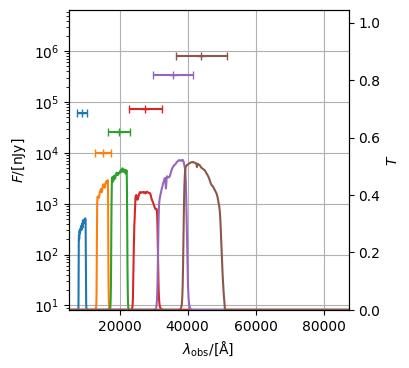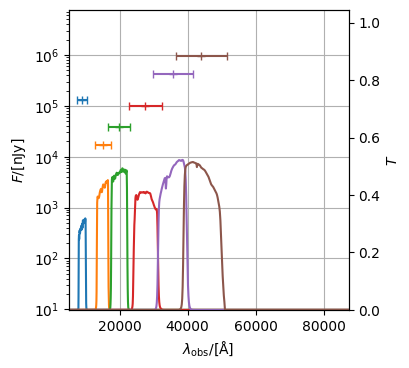Generating photometry from a Galaxy¶
If you are working with a Galaxy (or many Galaxy objects) containing multiple spectra, you can use the galaxy level get_photo_lnu and get_photo_fluxes methods to generate photometry for all spectra in the galaxy.
Before we can demonstrate this we firs need to make a parametric galaxy with a Stars and Blackhole component, define an emission model for a whole galaxy and generate their rest–frame and observed spectra.
[1]:
import numpy as np
from astropy.cosmology import Planck18 as cosmo
from unyt import Mpc, Msun, Myr, kelvin, yr
from synthesizer.emission_models import (
AttenuatedEmission,
BimodalPacmanEmission,
DustEmission,
EmissionModel,
UnifiedAGN,
)
from synthesizer.emission_models.attenuation import PowerLaw
from synthesizer.emission_models.dust.emission import Blackbody, Greybody
from synthesizer.filters import FilterCollection
from synthesizer.grid import Grid
from synthesizer.parametric import SFH, ZDist
from synthesizer.parametric import Stars as ParametricStars
from synthesizer.particle import BlackHoles, Galaxy
from synthesizer.particle.stars import sample_sfzh
# Get the grids which we'll need for extraction
grid_dir = "../../../tests/test_grid"
grid_name = "test_grid"
grid = Grid(grid_name, grid_dir=grid_dir)
nlr_grid = Grid("test_grid_agn-nlr", grid_dir="../../../tests/test_grid")
blr_grid = Grid("test_grid_agn-blr", grid_dir="../../../tests/test_grid")
# Define the metallicity history
zh = ZDist.DeltaConstant(metallicity=0.01)
# Define the star formation history
sfh_p = {"max_age": 100 * Myr}
sfh = SFH.Constant(**sfh_p)
# Initialise the parametric Stars object
param_stars = ParametricStars(
grid.log10age,
grid.metallicity,
sf_hist=sfh,
metal_dist=zh,
initial_mass=10**9 * Msun,
)
# Define the number of stellar particles we want
n = 500
# Sample the parametric SFZH, producing a particle Stars object
# we will also pass some keyword arguments for some example attributes
part_stars = sample_sfzh(
sfzh=param_stars.sfzh,
log10ages=param_stars.log10ages,
log10metallicities=param_stars.log10metallicities,
nstar=n,
current_masses=np.full(n, 10**8.7 / n) * Msun,
redshift=1,
coordinates=np.random.normal(0, 0.01, (n, 3)) * Mpc,
centre=np.zeros(3) * Mpc,
)
# Make fake properties
n = 4
masses = 10 ** np.random.uniform(low=7, high=9, size=n) * Msun
coordinates = np.random.normal(0, 0.01, (n, 3)) * Mpc
accretion_rates = 10 ** np.random.uniform(low=-2, high=1, size=n) * Msun / yr
metallicities = np.full(n, 0.01)
# And get the black holes object
blackholes = BlackHoles(
masses=masses,
coordinates=coordinates,
accretion_rates=accretion_rates,
metallicities=metallicities,
)
# And create the galaxy
gal = Galaxy(
stars=part_stars,
black_holes=blackholes,
redshift=1,
)
# Get the stellar pacman model
pc_model = BimodalPacmanEmission(
grid=grid,
tau_v_ism=1.0,
tau_v_birth=0.7,
dust_curve_ism=PowerLaw(slope=-1.3),
dust_curve_birth=PowerLaw(slope=-0.7),
dust_emission_ism=Blackbody(temperature=100 * kelvin),
dust_emission_birth=Blackbody(temperature=30 * kelvin),
fesc=0.2,
fesc_ly_alpha=0.9,
label="stellar_total",
)
# Get the UnifiedAGN model
uni_model = UnifiedAGN(
nlr_grid,
blr_grid,
covering_fraction_nlr=0.1,
covering_fraction_blr=0.1,
torus_emission_model=Blackbody(1000 * kelvin),
label="agn_intrinsic",
)
# Define an emission model to attenuate the intrinsic AGN emission
att_uni_model = AttenuatedEmission(
dust_curve=PowerLaw(slope=-1.0),
apply_to=uni_model,
tau_v=0.7,
emitter="blackhole",
label="agn_attenuated",
)
gal_intrinsic = EmissionModel(
label="total_intrinsic",
combine=(uni_model, pc_model["intrinsic"]),
emitter="galaxy",
)
gal_attenuated = EmissionModel(
label="total_attenuated",
combine=(att_uni_model, pc_model["attenuated"]),
related_models=(gal_intrinsic,),
emitter="galaxy",
)
# And now include the dust emission
gal_dust = DustEmission(
dust_emission_model=Greybody(30 * kelvin, 1.2),
dust_lum_intrinsic=gal_intrinsic,
dust_lum_attenuated=gal_attenuated,
emitter="galaxy",
label="dust_emission",
)
gal_total = EmissionModel(
label="total",
combine=(gal_attenuated, gal_dust),
related_models=(gal_intrinsic),
emitter="galaxy",
)
# Get the spectra
sed = gal.get_spectra(gal_total)
# Get fluxes
gal.get_observed_spectra(cosmo)
/tmp/ipykernel_6487/3518008903.py:14: FutureWarning: The filters module has been moved to the instruments module. Please update your imports synthesizer.filters -> synthesizer.instruments
from synthesizer.filters import FilterCollection
/opt/hostedtoolcache/Python/3.10.16/x64/lib/python3.10/site-packages/unyt/array.py:1824: RuntimeWarning: divide by zero encountered in log10
out_arr = func(np.asarray(inp), out=out_func, **kwargs)
/home/runner/work/synthesizer/synthesizer/src/synthesizer/particle/stars.py:629: RuntimeWarning: The use of singular axis names is deprecated. Update your grid file.
np.ascontiguousarray(grid.log10ages, dtype=np.float64),
/home/runner/work/synthesizer/synthesizer/src/synthesizer/particle/stars.py:630: RuntimeWarning: The use of singular axis names is deprecated. Update your grid file.
np.ascontiguousarray(grid.log10metallicities, dtype=np.float64),
/opt/hostedtoolcache/Python/3.10.16/x64/lib/python3.10/site-packages/unyt/array.py:1824: RuntimeWarning: overflow encountered in exp
out_arr = func(np.asarray(inp), out=out_func, **kwargs)
/opt/hostedtoolcache/Python/3.10.16/x64/lib/python3.10/site-packages/unyt/array.py:1949: RuntimeWarning: overflow encountered in multiply
out_arr = func(
We can then combine with a FilterCollection to generate the galaxy-level photometry.
[2]:
# Get the filter collection
fs = [
f"JWST/NIRCam.{f}"
for f in ["F090W", "F150W", "F200W", "F277W", "F356W", "F444W"]
]
filters = FilterCollection(
filter_codes=fs,
new_lam=grid.lam,
)
# Get the photometry
gal.get_photo_lnu(filters)
gal.get_photo_fnu(filters)
The photometry produced by these methods are stored in the photo_lnu and photo_fluxes attributes, either at the base galaxy level or the individual components. These attributes are dictionaries containing the photometry for each spectra key.
For example, on the Galaxy.Stars object:
[3]:
print(gal.stars.photo_lnu)
print(gal.stars.photo_fnu)
{'intrinsic': <synthesizer.photometry.PhotometryCollection object at 0x7f2901d510c0>, 'old_intrinsic': <synthesizer.photometry.PhotometryCollection object at 0x7f2901d53b80>, 'old_reprocessed': <synthesizer.photometry.PhotometryCollection object at 0x7f2901bbdc00>, 'old_nebular': <synthesizer.photometry.PhotometryCollection object at 0x7f2901d51d20>, 'old_linecont': <synthesizer.photometry.PhotometryCollection object at 0x7f2901bbded0>, 'old_nebular_continuum': <synthesizer.photometry.PhotometryCollection object at 0x7f2901d528c0>, 'old_transmitted': <synthesizer.photometry.PhotometryCollection object at 0x7f2901d53f10>, 'old_escaped': <synthesizer.photometry.PhotometryCollection object at 0x7f2901d53dc0>, 'young_intrinsic': <synthesizer.photometry.PhotometryCollection object at 0x7f2901bbdf90>, 'young_escaped': <synthesizer.photometry.PhotometryCollection object at 0x7f294cf43100>, 'young_reprocessed': <synthesizer.photometry.PhotometryCollection object at 0x7f294cf427d0>, 'young_transmitted': <synthesizer.photometry.PhotometryCollection object at 0x7f294cf41cf0>, 'young_nebular': <synthesizer.photometry.PhotometryCollection object at 0x7f294cf41f90>, 'young_linecont': <synthesizer.photometry.PhotometryCollection object at 0x7f294cf41b40>, 'young_nebular_continuum': <synthesizer.photometry.PhotometryCollection object at 0x7f2901d53d60>, 'attenuated': <synthesizer.photometry.PhotometryCollection object at 0x7f294cf41c00>, 'young_attenuated': <synthesizer.photometry.PhotometryCollection object at 0x7f294cf4b430>, 'young_attenuated_nebular': <synthesizer.photometry.PhotometryCollection object at 0x7f294cf4b070>, 'old_attenuated': <synthesizer.photometry.PhotometryCollection object at 0x7f294cf4ada0>}
{'intrinsic': <synthesizer.photometry.PhotometryCollection object at 0x7f2901d52830>, 'old_intrinsic': <synthesizer.photometry.PhotometryCollection object at 0x7f2901d524d0>, 'old_reprocessed': <synthesizer.photometry.PhotometryCollection object at 0x7f2901d538b0>, 'old_nebular': <synthesizer.photometry.PhotometryCollection object at 0x7f294cf49ed0>, 'old_linecont': <synthesizer.photometry.PhotometryCollection object at 0x7f294cf49300>, 'old_nebular_continuum': <synthesizer.photometry.PhotometryCollection object at 0x7f294cf4a050>, 'old_transmitted': <synthesizer.photometry.PhotometryCollection object at 0x7f294cf4a020>, 'old_escaped': <synthesizer.photometry.PhotometryCollection object at 0x7f294cf48af0>, 'young_intrinsic': <synthesizer.photometry.PhotometryCollection object at 0x7f294cf4a230>, 'young_escaped': <synthesizer.photometry.PhotometryCollection object at 0x7f294cf49e70>, 'young_reprocessed': <synthesizer.photometry.PhotometryCollection object at 0x7f28ff4fbd00>, 'young_transmitted': <synthesizer.photometry.PhotometryCollection object at 0x7f294cf4a200>, 'young_nebular': <synthesizer.photometry.PhotometryCollection object at 0x7f28f939d810>, 'young_linecont': <synthesizer.photometry.PhotometryCollection object at 0x7f28f939d9c0>, 'young_nebular_continuum': <synthesizer.photometry.PhotometryCollection object at 0x7f28f939db70>, 'attenuated': <synthesizer.photometry.PhotometryCollection object at 0x7f28f939dd20>, 'young_attenuated': <synthesizer.photometry.PhotometryCollection object at 0x7f28f939ded0>, 'young_attenuated_nebular': <synthesizer.photometry.PhotometryCollection object at 0x7f28f939e080>, 'old_attenuated': <synthesizer.photometry.PhotometryCollection object at 0x7f28f939e230>}
Or on the galaxy level
[4]:
print(gal.photo_lnu)
{'total': <synthesizer.photometry.PhotometryCollection object at 0x7f294cf48fd0>, 'dust_emission': <synthesizer.photometry.PhotometryCollection object at 0x7f294cf48eb0>, 'total_intrinsic': <synthesizer.photometry.PhotometryCollection object at 0x7f294cf48ca0>, 'total_attenuated': <synthesizer.photometry.PhotometryCollection object at 0x7f294cf48ac0>}
As before we can print the photometry.
[5]:
print(gal.photo_fnu["total_attenuated"])
-----------------------------------------------------
| PHOTOMETRY (FLUX) |
|------------------------------------|--------------|
| JWST/NIRCam.F090W (λ = 9.02e+03 Å) | 2.92e+03 nJy |
|------------------------------------|--------------|
| JWST/NIRCam.F150W (λ = 1.50e+04 Å) | 2.28e+03 nJy |
|------------------------------------|--------------|
| JWST/NIRCam.F200W (λ = 1.99e+04 Å) | 2.24e+03 nJy |
|------------------------------------|--------------|
| JWST/NIRCam.F277W (λ = 2.76e+04 Å) | 2.92e+03 nJy |
|------------------------------------|--------------|
| JWST/NIRCam.F356W (λ = 3.57e+04 Å) | 8.37e+03 nJy |
|------------------------------------|--------------|
| JWST/NIRCam.F444W (λ = 4.40e+04 Å) | 1.82e+04 nJy |
-----------------------------------------------------
Or plot them.
[6]:
gal.photo_fnu["total_attenuated"].plot_photometry(show=True)
[6]:
(<Figure size 350x500 with 2 Axes>,
<Axes: xlabel='$\\lambda_\\mathrm{obs}/[\\mathrm{\\AA}]$', ylabel='$F/[\\mathrm{\\rm{nJy}}]$'>)

[7]:
gal.photo_fnu["total_intrinsic"].plot_photometry(show=True)
[7]:
(<Figure size 350x500 with 2 Axes>,
<Axes: xlabel='$\\lambda_\\mathrm{obs}/[\\mathrm{\\AA}]$', ylabel='$F/[\\mathrm{\\rm{nJy}}]$'>)

[8]:
gal.photo_fnu["total"].plot_photometry(show=True)
[8]:
(<Figure size 350x500 with 2 Axes>,
<Axes: xlabel='$\\lambda_\\mathrm{obs}/[\\mathrm{\\AA}]$', ylabel='$F/[\\mathrm{\\rm{nJy}}]$'>)

Calculating light radii¶
Once we have photometry we can calculate the radius enclosing a given fraction of the light for a component. Here we’ll calculate the half light radius for both the intrinsic emission and the total emission in “F444W” in terms of luminosity, but before we can do that we need to get the particle spectra and call get_particle_photo_lnu to first calculate the per particle photometry (above we used the galaxy level methods to calculate integrated spectra).
[9]:
# Get the particle spectra
pc_model.set_per_particle(True)
gal.stars.get_spectra(pc_model)
# Get the particle photometry
gal.stars.get_particle_photo_lnu(filters)
int_r50 = gal.stars.get_half_luminosity_radius(
"intrinsic", "JWST/NIRCam.F444W"
)
tot_r50 = gal.stars.get_half_luminosity_radius(
"stellar_total", "JWST/NIRCam.F444W"
)
print(int_r50, tot_r50)
0.013907145761362323 Mpc 0.013908900988937385 Mpc
Similarly to the “attr” radii we can compute for any particle component, we can also compute the radius enclosing any fraction of the light for any particle component.
[10]:
int_r20 = gal.stars.get_luminosity_radius(
"intrinsic", "JWST/NIRCam.F444W", frac=0.2
)
tot_r20 = gal.stars.get_luminosity_radius(
"stellar_total", "JWST/NIRCam.F444W", frac=0.2
)
int_r80 = gal.stars.get_luminosity_radius(
"intrinsic", "JWST/NIRCam.F444W", frac=0.8
)
tot_r80 = gal.stars.get_luminosity_radius(
"stellar_total", "JWST/NIRCam.F444W", frac=0.8
)
print(int_r20, int_r80, tot_r20, tot_r80)
0.009755723005471876 Mpc 0.0196641356614788 Mpc 0.00975581637731331 Mpc 0.019754449241924037 Mpc